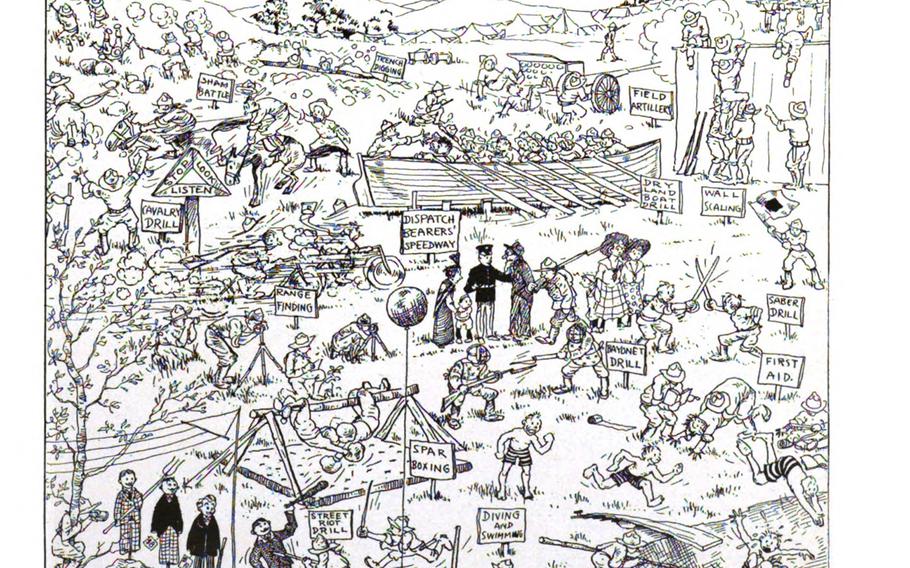
Cord Scott, a professor with the University of Maryland Global Campus in Okinawa, in August released, “The Mud and the Mirth: Marine Cartoonists in World War I." (Matthew M. Burke/Stars and Stripes)
CAMP FOSTER, Okinawa – History professor Cord Scott hopes his new book, “The Mud and the Mirth: Marine Cartoonists in World War I,” adds insight into the lives of ordinary Marine riflemen in World War I as the memory of that conflict has faded into history.
Scott, 53, teaches history, government and film through the University of Maryland Global Campus to classes of mostly service members on Okinawa. The Marine Corps University Press in August published his book on Marine Corps cartoons, he said Nov. 30 on Okinawa.
Frank Buckles, the last U.S. veteran of the Great War, died in 2011, according to the New York Times. The last Marine veteran, Albert Frederick “Jud” Wagner, died in Kansas in 2007, according to The Associated Press. Though living memory of the war is past, Scott said he hopes his book keeps some piece of it alive for future generations.
The collection of satirical and often biting panels inspired by the brutalities of war offers a unique perspective into the realities of life in the trenches.

This strip, by Abian A. “Wally” Wallgren, appeared in The Stars and Stripes in May 1918. (Cord Scott)
“Cartoons and comic strips and any sort of illustrative art can tell us more about history than just simple pictures,” Scott said. “It gives us insight of what your average individual was thinking about, and it also gives us an insight into what they think is humorous.”
World War I began with the assassination of Austrian archduke Franz Ferdinand by Serbian nationalists in June 1914. A network of alliances soon dragged Europe into a war that spread around the world. The United States originally abstained from the fight but declared war on Germany on April 6, 1917, and its ally Austria-Hungary two days later.
Estimates of military casualties range from 8.5 million to 10 million dead, including nearly 117,000 U.S. troops killed and 204,000 wounded.
Minot to Chicago
Scott grew up in Minot, N.D., earned a bachelor’s in history from Minot State University, a master’s in international relations from Baylor University and his doctorate in American history in 2011 from Loyola University Chicago. For his dissertation, he wrote, “Comics and Conflict: War and Patriotically Themed Comics in American Cultural History from World War II through Operation Iraqi Freedom.”
From a successful July 2018 presentation on Marine cartoons of World War I at the Marine Corps History Division in Quantico, Va., his 111-page book, “The Mud and the Mirth,” was born.

This strip, by Abian A. “Wally” Wallgren, appeared in The Stars and Stripes in December 1918. (Cord Scott)
The book starts with the genesis of political cartooning in the American colonies from
Benjamin Franklin’s 1754 “Live Free or Die” depiction of a fragmented snake to the Civil War era, when magazines like Harpers Weekly sent combat sketch artists to the battlefields. The era of yellow journalism produced the first syndicated comic strip, Richard F. Outcault’s “The Yellow Kid,” in the New York World in 1895.
Much of Scott’s book focuses on the work of Abian A. “Wally” Wallgren of the 5th Marine Regiment and a cartoonist for The Stars and Stripes newspaper. The paper was designed to keep enlisted troops apprised of news from back home and in Europe.
Wallgren, a sign painter and serial doodler, fell naturally into the newspaper. His cartoons in Scott’s book reflect the times, and some feature racist depictions of the enemy and friendly nationalities, but they also reveal the conflict’s brutality.
In one Wallgren strip, “Directions for the Proper Care of the Rifle,” a Marine says that stabbing a German with a bayonet will provide the proper grease for the blade.
On lighter notes, Wallgren pokes fun at the typical enlisted targets: officers, equipment, conditions, food, tactical decisions and other service branches. Common themes like homesickness, longing for loved ones and esprit de corps also emerge.
Life-and-death humor
Overwhelmingly, the strips provide a dose of humor. In another Wallgren strip, “Spiral Puttees” from May 10, 1918, a Marine struggles to put on his wrapped leggings. In each panel he gets more and more frustrated as he becomes increasingly entangled.
“Anytime you throw anybody into a situation where it’s life and death, people are going to go to what can ease the tension, and humor is part of that,” Scott said.
The book is a much-needed addition to Marine Corps history, said Mark Folse, a former Marine infantryman and current historian at the U.S. Army Center of Military History at Fort McNair, Washington, D.C.

This strip, “All in the Day's Work," by Charles Gatchell ran in the Recruiters' Bulletin in June 1917. (Cord Scott)
He said most Marines serve single enlistment, and their lives as junior enlisted Marines are hard and unpleasant.
“Much of the Marine Corps’ history and story is told from the Marines who stay in their entire lives; it’s lieutenant generals, it’s lieutenant colonels,” Folse said. “It’s an awesome breadth of experience, but what’s missing from all of that is what I think is the majority of people’s experience with the Marine Corps. This is a crucial look into an important facet of Marine Corps institutional culture.”
“The Mud and the Mirth: Marine Cartoonists in World War I” is available free from the Marine Corps University Press at https://www.usmcu.edu/Outreach/Publishing/Marine-Corps-University-Press/Books-by-topic/.